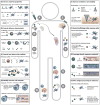Improving Vaccine and Immunotherapy Design Using Biomaterials
- PMID: 29249461
- PMCID: PMC5914493
- DOI: 10.1016/j.it.2017.10.002
Improving Vaccine and Immunotherapy Design Using Biomaterials
Abstract
Polymers, lipids, scaffolds, microneedles, and other biomaterials are rapidly emerging as technologies to improve the efficacy of vaccines against infectious disease and immunotherapies for cancer, autoimmunity, and transplantation. New studies are also providing insight into the interactions between these materials and the immune system. This insight can be exploited for more efficient design of vaccines and immunotherapies. Here, we describe recent advances made possible through the unique features of biomaterials, as well as the important questions for further study.
Keywords: autoimmunity and transplantation; biomaterial and nanotechnology; cancer; infectious disease; nanoparticle and microparticle; vaccine and immunotherapy.
Copyright © 2017 Elsevier Ltd. All rights reserved.
Figures


References
Publication types
MeSH terms
Substances
Grants and funding
LinkOut - more resources
Full Text Sources
Other Literature Sources
Medical

